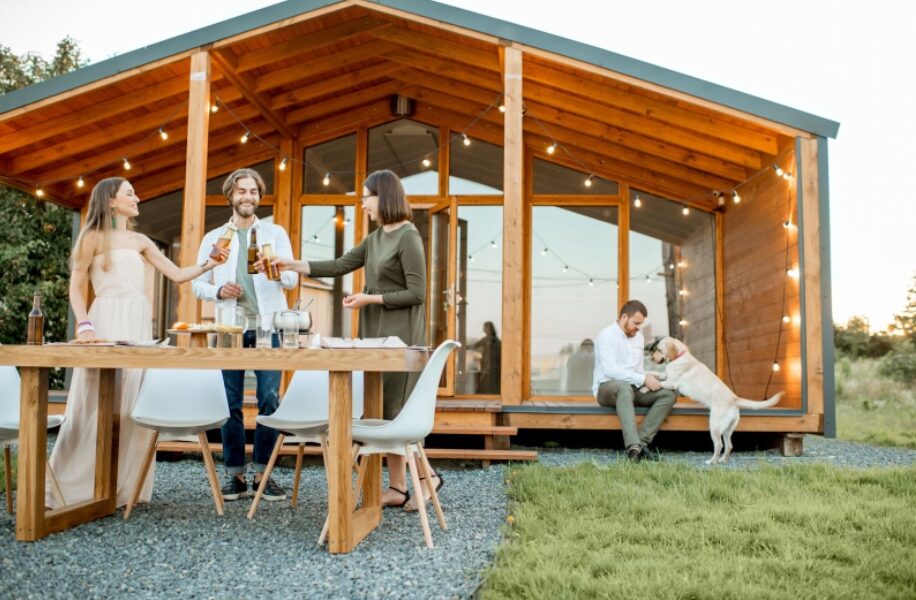Building a Vacation Home: What You Need to Know

Seems like you’re planning on building a vacation home. Great news! A vacation home is all about creating a space that serves as a true escape, where comfort, style, and practicality come together seamlessly. Whatever style you’ve got in mind, remember that a successful journey always starts with careful planning.
From choosing the right location to selecting an adaptable layout, there truly are many aspects to consider. But, by focusing on the key elements of design, sustainability, and personal touches, you can create a vacation home that perfectly reflects your vision and meets your needs for years to come. So, let’s get started!
Choosing the Right Floor Plan for Your Vacation Home
Before you start building, you must know what you’re building! It’s essential to decide on the type of home and layout that suits your needs and lifestyle. A well-thought-out floor plan will set the foundation for a vacation home that is both comfortable and practical. Whether you’re looking for something spacious and open or a layout that provides cozy corners and private retreats, there are many home plans to consider. Luckily, we’re here to help you!
Here are some of the best options that can help you create a functional vacation home:
- Barndominium Floor Plans: Barndominiums are becoming a popular choice for vacation homes due to their versatility and ability to blend rustic charm with modern amenities. These homes feature open floor plans that allow for large, expansive living spaces, perfect for social gatherings and family time.
With options to add lofts for extra sleeping areas, large garages for recreational vehicles, or high-ceiling great rooms for an airy feel, Barndominium floor plans offer a high level of customization. This flexibility makes it easy to adapt the space to your specific needs, whether it’s for hosting guests, creating a cozy retreat, or having a multi-functional space for hobbies and relaxation.
- Open-Concept Living Plans: If you want your vacation home to have a seamless flow between spaces, an open-concept layout might be the way to go. This type of design connects living, dining, and kitchen areas into one large, open space, making the home feel bigger and more inviting.
Open-concept plans are ideal for those who love to entertain, as they provide a great environment for socializing and keeping everyone together. They also help maximize natural light and views, giving the home a bright and airy atmosphere.
- Multi-Generational Floor Plans: For those who plan to have extended family or friends stay over, a multi-generational floor plan can be a perfect fit. These designs often include separate suites or wings that provide privacy and comfort for everyone.
With features like multiple master suites, separate entrances, or a guest cottage on the property, these plans make it easy to host guests without compromising on personal space. This layout ensures that the home feels spacious and functional, accommodating different needs and lifestyles under one roof.
- Compact and Efficient Plans: If your idea of a vacation home is a cozy cabin or a small beach house, compact floor plans can offer a smart use of space. These designs focus on making the most out of every square foot, incorporating clever storage solutions and multipurpose rooms to avoid clutter.
They are perfect for those who want a simpler, low-maintenance home that still feels comfortable and welcoming.
Once you carefully select a floor plan that fits your vision and needs, you can ensure that your vacation home will be both a beautiful and functional space for years to come.
Choosing the Right Location
Now that you know what type of vacation house you want, we can move on to the location. Selecting the perfect location for your vacation home is crucial and involves more than just finding a beautiful view. It’s about aligning the location with your lifestyle, needs, and future plans. Here are a few factors to consider:
- Climate and Environment: The local climate will affect everything from the materials you choose to the style of your vacation home. For example, homes in coastal areas might need to withstand saltwater corrosion, while mountain homes need to be prepared for snow and colder temperatures.
- Accessibility and Convenience: Think about how often you’ll visit and how accessible the location is year-round. Proximity to airports, highways, and essential amenities like grocery stores and healthcare facilities can make a significant difference in your experience.
- Local Regulations and Zoning Laws: Researching local building codes and restrictions is vital. Some areas have strict guidelines on home size, height, design elements, and even the colors you can use, which could impact your plans significantly.
- Surrounding Community and Services: Consider the kind of community you want to be part of and the services available nearby. A secluded location might offer tranquility but could lack essential services, while a more developed area provides convenience but might not offer as much privacy.
By carefully considering these factors, you ensure that your vacation home will not only be beautiful but also practical and enjoyable for years to come.

Incorporating Sustainable and Energy-Efficient Elements
Designing a vacation home with sustainability in mind is not only good for the environment but also adds long-term value by reducing maintenance and operational costs. Here’s how you can incorporate sustainable and energy-efficient elements:
- Use of Sustainable Materials: Opt for building materials that have a low environmental impact, such as reclaimed wood, recycled metal, or bamboo. These materials not only add unique character to your home but also help reduce the carbon footprint associated with construction. Natural stone and locally sourced materials are also great choices, reflecting the surrounding environment while minimizing transportation emissions.
- Energy-Efficient Systems: Invest in high-performance windows, superior insulation, and energy-efficient appliances to keep your home comfortable throughout the year while lowering energy bills. Consider adding solar panels or wind turbines to generate renewable energy, which can be especially beneficial in remote areas where power supply might be limited or costly.
- Water Conservation: Install water-efficient fixtures and systems like low-flow faucets, dual-flush toilets, and rainwater harvesting systems. Landscaping with native, drought-resistant plants can further reduce water usage and enhance the natural beauty around your vacation home.
We know all this may seem a bit unnecessary, but, in reality, it’s truly essential for the future of our planet! Incorporating these elements ensures your vacation home is not only comfortable but also aligns with sustainable living practices, making it a responsible choice for the future.
Considerations for Comfort and Practicality

Comfort and practicality should be at the forefront of your design decisions to ensure that your vacation home meets both your immediate and long-term needs. After all, a vacation house should provide just that – vacation. So, how can you keep your visits relaxing and make the maintenance the least of your worries?
Here are some essential features to include:
- Ample Storage: Make room for essentials like linens, beach gear, or winter sports equipment. Built-in cabinets, under-bed storage, and multipurpose furniture can help maximize space without cluttering it.
- Functional Kitchen Design: The kitchen is often the heart of a home, even in a vacation retreat. A well-designed kitchen with durable countertops, sufficient storage, and modern appliances can make preparing meals a pleasure, whether you’re cooking a simple breakfast or hosting a dinner party.
- Outdoor Spaces: Think about how outdoor spaces will complement the indoor areas. Whether it’s a deck overlooking a lake, a fire pit for cozy evenings, or a covered patio for all-weather relaxation, outdoor spaces can greatly enhance the overall experience of the home.
One more thing to remember is that you should always balance comfort with low-maintenance choices. Select materials and finishes that are durable and easy to clean. For example, tile flooring is not only stylish but also easier to maintain than carpets, which might not suit high-traffic areas in a vacation home.
Budgeting and Financial Planning
Building a vacation home is a significant investment, and careful budgeting and financial planning are essential to avoid surprises. Here are some key considerations to keep in mind:
- Establish a Realistic Budget: Start by determining how much you’re willing to invest in your vacation home. This budget should cover not just the construction costs but also land acquisition, permits, interior finishes, landscaping, and any additional features like pools or outdoor kitchens. Remember to include a contingency fund (usually 10-15% of the total budget) to account for unexpected expenses that may arise during construction.
- Consider Long-Term Costs: It’s important to think beyond the initial build. Factor in the costs of property taxes, insurance, maintenance, utilities, and potential homeowner association (HOA) fees if applicable. Sustainable features, like energy-efficient systems and durable materials, might have higher upfront costs but can result in long-term savings on energy bills and maintenance.
- Explore Financing Options: Depending on your financial situation, consider different financing options, such as a second mortgage, home equity loan, or construction loan. Working with a financial advisor or lender familiar with vacation properties can provide insights into the best route for you, including tax implications and the benefits of rental income if you decide to rent out the property when not in use.
- Plan for Future Value: Consider how the value of your vacation home may appreciate over time. Investing in quality materials, timeless design, and desirable locations can enhance your property’s value, making it a smart long-term investment.
With a clear and comprehensive financial plan, you can confidently move forward in building a vacation home that meets both your budget and your dreams. And, after all that hard work, you’ll finally have a beautiful place to rest!
Final Thoughts
As you can see, building a vacation home involves thoughtful planning and smart choices. From picking the perfect location to designing a space that blends comfort, style, and sustainability, every step matters. With the right approach, you can create a getaway that feels both timeless and uniquely yours – a place where every visit feels like coming home.





